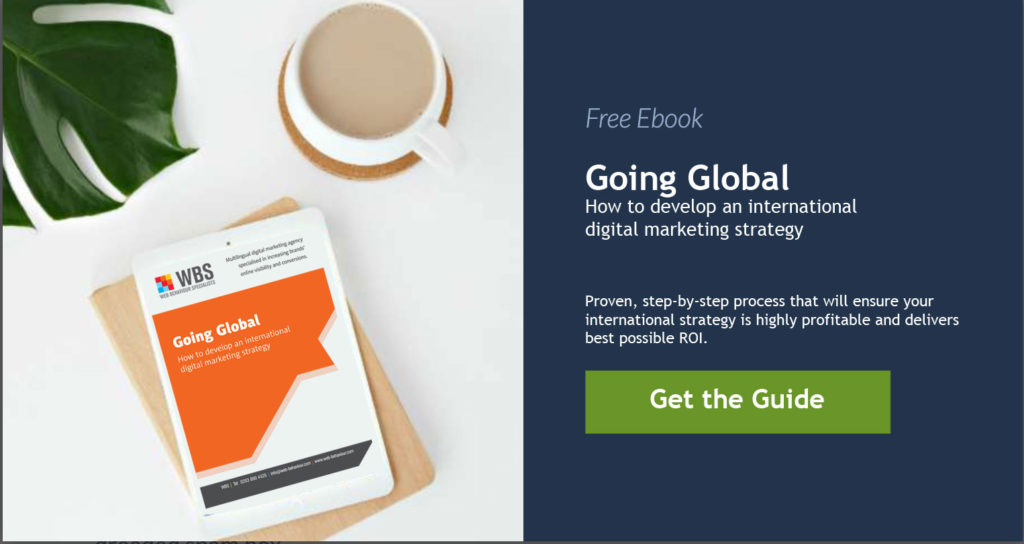When expanding internationally, businesses have to make sure their global marketing strategy is in line with their overall marketing objectives. Knowing what your customers want and who they are or simply applying your domestic strategy to international markets, isn’t enough. When working on an international marketing strategy, elements like cultural differences, language, local events, seasonality, local laws, logistics etc. are crucial to being successful.
For an international digital marketing strategy to be effective, there are a number of key steps that must be followed. We’re going to cover the most important ones here. If you’d like to read more, check out our Going Global guide.
1. Research
Marketing to an international audience is a lot more challenging than marketing locally. Not only should we research the targeted country and what kind of opportunity there is to grow our business there, but we also need to research base elements like our competitors and target audience.
Competitive landscape research is an essential step as our competition will most likely be different in each country. You may be in direct competition with brands who are already well established in your desired location. It may feel like you’re starting from scratch.
 It’s a good idea to identify the brands your business will be up against and assess their strengths and weaknesses. This will help you find opportunities where your brand could stand out and build ideas for your future campaigns.
It’s a good idea to identify the brands your business will be up against and assess their strengths and weaknesses. This will help you find opportunities where your brand could stand out and build ideas for your future campaigns.
Do you know who your audience is and is it the same across countries? The consumer decision making journey is much more complex than it used to be. Loyalty is now much harder to achieve as purchasing decisions are often made subconsciously. Moreover, the decision making journey might differ depending on location and local habits. To develop a successful international digital marketing strategy, you need to understand how consumer decision making might differ in each of your target markets. Also, how you might adjust your marketing message based on geography and culture.
2. Develop a plan
Once you’ve done your research, uncovered your potential competition and understand your target audience, it’s time to develop a marketing plan. So where do you start?
Define the Objectives
 Defining the digital marketing objective is the initial aspect of any digital marketing strategy. It’s no different for international strategies.
Defining the digital marketing objective is the initial aspect of any digital marketing strategy. It’s no different for international strategies.
Setting up goals will help you set the overall direction of the business. As well as your marketing activities on a market by market basis. Those objectives can be revisited over time and adjusted to each market’s fluctuations.
Choose the Right Channels
For every digital marketing strategy, you need to choose the right channels for your audience which will help you achieve your set objectives. You might be tempted to just apply your domestic strategy to new markets. However, we need to be conscious of the fact that people in other countries behave differently. Their search and buying habits vary, so every strategy has to be customised based on local knowledge.
Multichannel digital marketing campaigns bring much better results than single channel ones, so taking advantage of that is a no-brainer. Read more on the effectiveness of multichannel marketing strategies.
Budget allocation
There are lots of stats available on how much budget should be allocated to marketing campaigns, digital marketing and to each channel. However, budget allocation depends on several things. Such as, the nature of your business, buying customer journey, your strategy, chosen channels, available budget at a specific time and the life cycle of your company. You can find more information on how to fix a marketing budget and allocate it between different channels on our Digital Marketing Strategy guide.
Budget allocation for an international strategy is even more complicated. We also have to decide how to allocate budget, not only between channels, but also between countries.
Don’t forget that you should plan strategically and flexibly. Not every estimation you make is going to be correct. Especially when planning for new markets, so every plan must be adaptable. You may need to amend the budget or, based on results, change the budget allocation between different channels and/or countries.
Test, Test, Test
Testing is an essential element of any digital marketing campaign. The amount of data and the speed at which we can gather it. We can optimise our campaigns for performance daily. Giving digital a distinct advantage over traditional, less dynamic and less flexible forms of marketing. Testing is not only important across the each channel (e.g. what kind of message resonates best with your audience) but also across markets. What is working in the UK, doesn’t necessarily work in e.g. The Netherlands.
3. Content marketing
Most businesses will already be producing content of some sort. Whether it’s blog posts, a podcast, YouTube videos or image galleries. It’s important that the format reflects your audience’s preferences. You can share your content strategically via digital channels: email, social networks, messaging apps, etc. Done well, content marketing can be the most effective way for your business to find, convert and retain customers. For the international aspect of a digital marketing strategy, global content marketing can grow your business to the next level. As long as you understand the importance of adapting your content for each regional market.
Read how to develop an international digital marketing strategy
When expanding into local markets, you need to be prepared to connect with your audience on their terms. Use their preferred digital channels and communicate in their native language.
It’s a good idea to create a library of content that can be reused via different channels but also localised and used across markets.
Various ideas should be incorporated into the content marketing strategy because diverse content serves different purposes. One piece of content (e.g. an old blog post) you can be develop as an e-book. Then, turn it into an in-depth article/whitepaper, make into an infographic or develop as an explainer video which you can be share across markets and channels.
Read more on how to develop an effective content strategy.
When thinking about international presence or expansion, it’s crucial for businesses to:
- Know and understand the market
- Set clear objectives
- Have a multichannel plan with budget strategy
- Prepare a content strategy
- Test, test, test
There’s a lot to be researched and considered before developing an international digital marketing strategy. However, a well designed international digital marketing strategy will help you plan and adapt your marketing activities. Also, to effectively reach your audience in your targeted international markets.
Whether you’re looking to expand internationally or you already have a global presence but feel that results could be better, give us a call. Our team can review your strategy/campaigns and help to hit your targets going forward.









